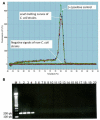Fate and Survival of Campylobacter coli in Swine Manure at Various Temperatures
- PMID: 22207868
- PMCID: PMC3245958
- DOI: 10.3389/fmicb.2011.00262
Fate and Survival of Campylobacter coli in Swine Manure at Various Temperatures
Abstract
Campylobacter coli is the most common Campylobacter species found in pig (95%), but the ability of this bacterium to survive in swine manure as well as the potential for causing human illness are poorly understood. We present here laboratory-scale experiments to investigate the effect of temperature on the survival of C. coli in spiked swine manure samples at temperatures from 4 to 52°C. The survival of C. coli during storage for 30 days was studied by three different methods: bacterial culture (plate counting), DNA qPCR, and mRNA RT-qPCR. The results indicate that C. coli could survive in swine manure up to 24 days at 4°C. At higher temperatures, this bacterium survived only 7 days (15°C) or 6 days (22°C) of storage. The survival of C. coli was extremely short (few hours) in samples incubated at 42 and 52°C. The results from the RT-qPCR method were consistent with the data from the bacterial culture method, indicating that it detected only viable C. coli cells, thus eliminating false-positive resulting from DNA from dead C. coli cells.
Keywords: Campylobacter coli; RT-qPCR; ceuE; mRNA; swine manure.
Figures



Similar articles
-
Occurrence of Salmonella, Campylobacter, Yersinia enterocolitica, Escherichia coli O157 and Listeria monocytogenes in swine.Zoonoses Public Health. 2010 Sep;57(6):388-96. doi: 10.1111/j.1863-2378.2009.01248.x. Zoonoses Public Health. 2010. PMID: 19638163
-
Comparison of microbial communities in swine manure at various temperatures and storage times.Asian-Australas J Anim Sci. 2018 Aug;31(8):1373-1380. doi: 10.5713/ajas.17.0704. Epub 2018 Jan 26. Asian-Australas J Anim Sci. 2018. PMID: 29381907 Free PMC article.
-
Analysis of Escherichia coli O157:H7 survival in ovine or bovine manure and manure slurry.Appl Environ Microbiol. 1998 Sep;64(9):3166-74. doi: 10.1128/AEM.64.9.3166-3174.1998. Appl Environ Microbiol. 1998. PMID: 9726855 Free PMC article.
-
Fate of Escherichia coli O157:H7 during composting of bovine manure in a laboratory-scale bioreactor.J Food Prot. 2003 Jan;66(1):25-30. doi: 10.4315/0362-028x-66.1.25. J Food Prot. 2003. PMID: 12540177
-
Pathogen survival in swine manure environments and transmission of human enteric illness--a review.J Environ Qual. 2003 Mar-Apr;32(2):383-92. doi: 10.2134/jeq2003.3830. J Environ Qual. 2003. PMID: 12708660 Review.
Cited by
-
Seasonality and zoonotic foodborne pathogens in Canada: relationships between climate and Campylobacter, E. coli and Salmonella in meat products.Epidemiol Infect. 2019 Jan;147:e190. doi: 10.1017/S0950268819000797. Epidemiol Infect. 2019. PMID: 31364535 Free PMC article.
-
Survival with a Helping Hand: Campylobacter and Microbiota.Front Microbiol. 2015 Nov 9;6:1266. doi: 10.3389/fmicb.2015.01266. eCollection 2015. Front Microbiol. 2015. PMID: 26617600 Free PMC article.
-
Persistence and Potential Viable but Non-culturable State of Pathogenic Bacteria during Storage of Digestates from Agricultural Biogas Plants.Front Microbiol. 2016 Sep 14;7:1469. doi: 10.3389/fmicb.2016.01469. eCollection 2016. Front Microbiol. 2016. PMID: 27695451 Free PMC article.
-
Fate of Viable but Non-culturable Listeria monocytogenes in Pig Manure Microcosms.Front Microbiol. 2016 Mar 2;7:245. doi: 10.3389/fmicb.2016.00245. eCollection 2016. Front Microbiol. 2016. PMID: 26973623 Free PMC article.
-
Inactivation of selected bacterial pathogens in dairy cattle manure by mesophilic anaerobic digestion (balloon type digester).Int J Environ Res Public Health. 2014 Jul 14;11(7):7184-94. doi: 10.3390/ijerph110707184. Int J Environ Res Public Health. 2014. PMID: 25026086 Free PMC article.
References
-
- Andreoletti O., Budka H., Buncic S., Collins J. D., Griffin J., Hald T., Havelaar A., Hope J., Klein G., Mclauchlin J., Müller-Graf C., Nguyen-The C., Noerrung B., Peixe L., Maradona M. P., Ricci A., Sofos J., Threlfall J., Vågsholm I., Vanopdenbosch E. (2011). Scientific opinion on Campylobacter in broiler meat production: control options and performance objectives and/or targets at different stages of the food chain. EFSA J. 9, 141
-
- Anonymous (2006). Microbiology of Food and Animal Feeding Stuffs-Horizontal Method for Detection and Enumeration of Campylobacter spp. BS EN ISO 10272-1:2006. London: British Standards Institution
-
- Bang D. D., Nielsen E. M., Scheutz F., Pedersen K., Handberg K., Madsen M. (2003). PCR detection of seven virulence and toxin genes of Campylobacter jejuni and Campylobacter coli isolates from Danish pigs and cattle and cytolethal distending toxin production of the isolates. J. Appl. Microbiol. 94, 1003–101410.1046/j.1365-2672.2003.01926.x - DOI - PubMed
LinkOut - more resources
Full Text Sources
Molecular Biology Databases

